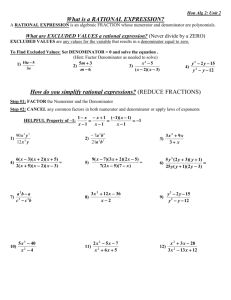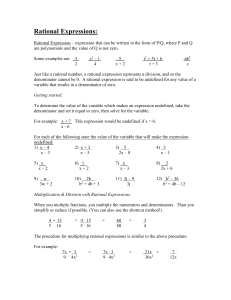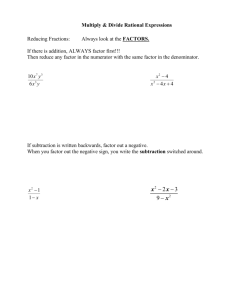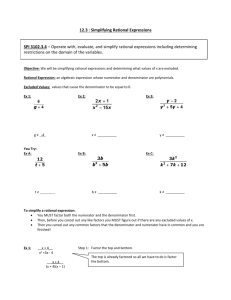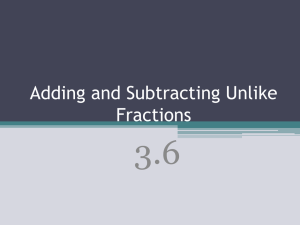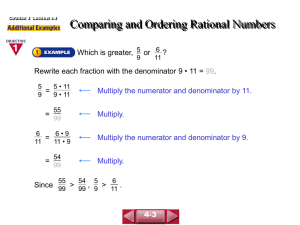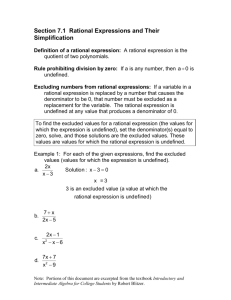Lesson9
advertisement
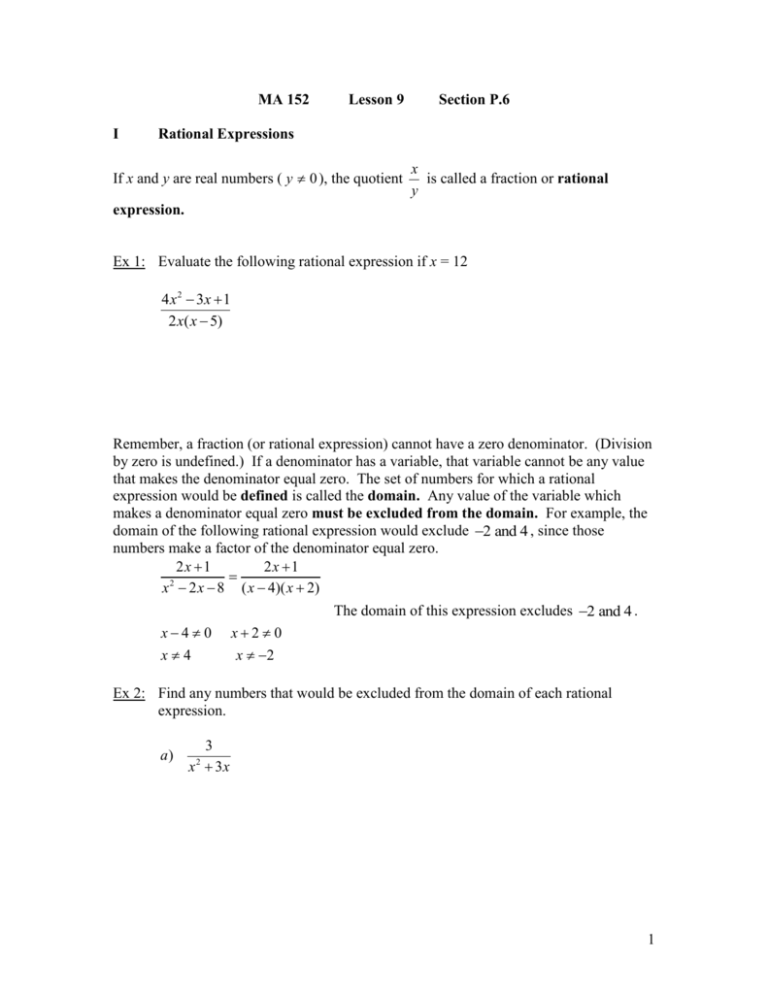
MA 152 I Lesson 9 Section P.6 Rational Expressions If x and y are real numbers ( y 0 ), the quotient x is called a fraction or rational y expression. Ex 1: Evaluate the following rational expression if x = 12 4 x 2 3x 1 2 x( x 5) Remember, a fraction (or rational expression) cannot have a zero denominator. (Division by zero is undefined.) If a denominator has a variable, that variable cannot be any value that makes the denominator equal zero. The set of numbers for which a rational expression would be defined is called the domain. Any value of the variable which makes a denominator equal zero must be excluded from the domain. For example, the domain of the following rational expression would exclude 2 and 4 , since those numbers make a factor of the denominator equal zero. 2x 1 2x 1 2 x 2 x 8 ( x 4)( x 2) The domain of this expression excludes 2 and 4 . x4 0 x4 x20 x 2 Ex 2: Find any numbers that would be excluded from the domain of each rational expression. a) 3 x 3x 2 1 II b) x2 x 5x 6 c) 5x 2 4x2 1 2 Simplifying Rational Expression 1. Factor the numerator and denominator completely. 2. Divide both numerator and denominator by any common factors. *Note: Determine what values would be excluded from the domain prior to dividing out any common factors. Ex 3: Simplify each fraction. Determine what value(s) would be excluded from the domain. III a) x 2 25 x 2 10 x 25 b) 9 x2 x 2 7 x 12 Multiplication and Division of Rational Expressions 1. 2. 3. 4. Factor all numerators and denominators completely. Divide numerators and denominators by common factors. For division, multiply by the reciprocal of the divisor. Multiply the remaining factors in the numerators and multiply the remaining factors in the denominators. Answers may be left in factored form. *Again, determine any values that would be excluded from the domain before dividing out any common factors. 2 Ex 4: Multiply or divide the following and write in simplest form Determine what value(s) would be excluded from the domain. a) IV y2 2 y 1 y 2 y y2 y 2 b) a 2 5a 6 a 2 4 a 2 6a 9 a 2 2a c) 2 x x2 1 x 2 3x 2 2 x 2 x 6 Addition and Subtraction with the Same Denominator. Addition and Subtraction of Fractions: a c ac a c a c b b b b b b 1. Add or subtract numerators. (Be careful to distribute the minus to every term that is subtracted. See study tip on page 77 of textbook.) 2. Factor numerator and denominator completely. 3. Divide out any common factors. Answer may be left in factored form. *Again, the numbers excluded from the domain are determined before any simplifying is completed. Ex 5: Find the sum or difference in simplest form. Write any values that would be excluded from the domain. a) 6x 3 x2 x2 3 b) V x 3x 2 x 1 x 1 Finding a Least Common Denominator The least common denominator, or LCD, of two or more rational expressions is the product of all prime factors in the denominators, with each factor raised to the greatest power of its occurrence in any denominator. 1. Factor each denominator completely. 2. List all the different factors from each denominator. 3. Raise each factor to the greatest power it occurs in any denominator. Ex 6: Find the least common denominator for each. VI a) 2 3 x x3 LCD = b) 4 5 2 9 x 6 xy LCD = c) x 2 2 x 4 x 4x 4 d) y 5 2 2 y y6 y y2 2 2 LCD = LCD = Addition and Subtraction with Different Denominators. 1. Find the LCD of the rational expressions. 2. Multiply each numerator and denominator of a rational expression by any factor(s) necessary to convert the denominator into the LCD. 3. Add or subtract numerators, placing the resulting expression over the LCD. 4. If possible, simplify the resulting rational expression. 4 *Again, you may be asked to list all values that are excluded from the domain. Do this before simplifying. Ex 7: Add or Subtract. Write answer in simplest form. Determine any numbers that should be excluded from the domain. a) 3 x x 4 x5 b) b2 4 2 2 b 4 b 2b c) 3 4 5 x 1 1 x d) 2 1 3 w 1 w 1 e) x 5 9x 3 2 x3 x3 x 9 2 5 VII Simplifying Complex Rational Expressions. Complex rational expressions, also called complex fractions, have numerators or denominators containing one or more rational expression (fractions within a fraction). The textbook shows two methods for simplifying such expressions. These two methods are found on page 81 of the textbook. Because students often get confused if both methods are demonstrated in class, I often show only one method. However, students are welcome to use either method or both methods. Method 1 1. Add or subtract the terms in the numerator and/or denominator so that the numerator and denominator are single expressions. 2. Perform the division by inverting the denominator and multiplying. Method 2 1. Find the LCD of all the rational expression in both the numerator part and the denominator part. 2. Multiply the numerator and denominator by this LCD *Note: The values excluded from the domain include any values that made original denominators zero and any values that make the division problem’s denominators zero. Ex 8: Simplify each. Find any values excluded from the domain for (a) and (b). a) 4x2 9 = x 18 b) 2 2 x 3 = 4 4 x 3 6 c) a b = a2 1 b2 d) 1 m = 1 3 m m 1 m 3 Sometimes a rational expression can model real life situations. 140 x Ex 9: The rational expression models the cost, in millions of dollars, to 100 x inoculate x percent of the population against a certain type of flu strain. a) Find the cost if 20% are inoculated? 60% inoculated? b) For what value of x is the expression undefined? What does this mean? c) What happens to the cost as x approaches 100%? 7


